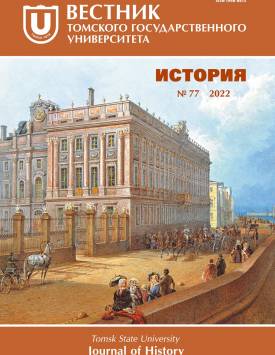Huvaanak - traditional divination of tuvan shamans
The study of divination, as one of the main functions of shamanic work, is a very important part of the research on shamanism. The main object of this paper is to study the Huvaanak divination of Tuva, its characteristics and divination methods as well as divination techniques similar to Huvaanak in other regions and ethnic cultures, in order to find similarities and establish characteristics of these divinations. On the basis of the results of these analytical comparisons, the author analyzes the unique methods of the Khuvanak divination of shamans, which were observed and registered by the author in the Republic of Tuva. The similarity of divination in so many places and regions of the world provokes curiosity about its origin. The author summarizes the studies of different scholars on its origin and concludes, that it is a very ancient method of divination. The resources of the study include: specialized literature on divination, information from the Internet (blogs and videos) and author's fieldwork results. The main research methods of this article are analysis and comparison, as well as observations and interviews used in fieldwork. On the basis of literary sources, this article analyses and compares similar methods of divination for the following ethnic groups: Kazakhs, Mongols, Kyrgyz, Uzbeks, Karachai-Balkars, Ubykhs. Similar methods of divination also exist in Bosnia and Herzegovina and Iraq. Literature analysis shows that methods of divination in these regions and within these ethnic groups are in many ways similar to those of Huvaanak, except that in some cases not only stones are used for divination, but also beans and sheep dung. It should be pointed out in this context, that there is a shaman in Tuva who owns the unique method of divination Huvaanak. The divination process of this shaman differs from the divination process of other Tuvan shamans and from the divination process described in the literature. His method differs not only in the way the stones are placed, but also in the way the stones are interpreted. Among his stones there are some of special colors, and their positions have a certain unique meaning. These are special methods that have not been described in literature before. The article also discusses the fact that the Huvaanak method of divination is somehow similar to an ancient Chinese method of divination and to some methods of divination in Tibetan Buddhism. Consequently, we can conclude that Huvaanak is a universal and a very old method of divination. The author declares no conflicts of interests.
Keywords
Huvaanak,
divination,
shamanism,
Tuva Republic,
kumalakAuthors
| Jiasina Duerdong | Tomsk State University | duerdun@yandex.ru |
Всего: 1
References
Hoppal M. Shamans and traditions. Akademie Kiado, 2007. 188 p.
Vocabulary for the Study of Religion / R.A. Segal, K. von Stuckrad (eds.). Leiden : Brill, 2015. 1842 p.
Wardle D. Cicero on Divination: De Divinatione. Oxford, 2006. Book 1. xii + 469 p.
Оельшлаегел А.К. Тувинское гадание «хуваанак» - вопросы к природе // Музей в XXI веке: проблемы и перспективы : материалы Междунар. науч.-практ. конф., Кызыл, 21-24 сентября 2005 г. / Национальный музей «Алдан Маадыр»; сост. А.О. Дыртык-оол. Кызыл, 2005. С.89-95.
Даржа В. Тайны мировоззрения тувинцев-номадов. Кызыл : Тув. кн. изд-во, 2007. 255 с.
Oelschlaegel A.C. Deutung und Wahrheit. Zwei Divinationspraktiken bei den Tyva im Suden Sibiriens // “Roter Altai, gib Dein Echo!” : Festschrift fur Erika Taube zum 65. Geburtstag / A.C. Oelschlagel, I. Nentwig, J. Taube (Hg.). Leipzig : Leipziger Universitatsverlag, 2005. S. 377-400.
Айыжы Е.В., Монгуш А.М. Охотничьи традиции тувинцев: этнографический аспект // Oriental Studies. 2020. Т. 13. № 5. С. 1359-1370.
Яковлев В.М. Кумалак ашу - устная традиция гадания и ее вероятные истоки // Российская тюркология. 2017. № 1-2. С. 158-167.
Inan A. Tarihte ve Bugun §amanizm. Materyaller ve Ara§tirmalar. Ankara : Turk Tarih Kurumu, 2000.
Tavkul U.: Ufuk Tavkul «Kipyak Kokenli Turk Boylarinda “Kurek Kemigi” ve “Kumalak-Ta§” Fall» // Qagda§ Turkl Ara§tirmalan Sempozyumu Bildirileri. 2003. Cilt 2. S. 181-190.
Большой словарь монгольского языка (Монгол Хэлний их тайлбар тол). URL: https://mongoltoli.mn/search.php?ug_id=108960&opt=1&word=%D0%A5%D0%9E%D0%92%D0%9E%D0%9B%D0%93%D0%9E (дата обращения: 19.03.2021).
Ли Юан. Синьцзян мэнгуцзу миньцзянь синьян юй шэхуй тяньедяоча Полевые исследования монголь ских народных верований и общества в Синьцзян. Миньцзу чубаньшэ, 2011. С. 118.
Fortune telling // Falanje.com. URL: https://web.archive.org/web/20130305174411/http://www.falanje.com/page.php?15 (accessed: дата обращения: 19.03.2021).
Encyclopaedia Perthensis, or Universal dictionary of the arts, sciences, literature, &c.intended to supersede the use of other books of reference. Printed by J. Brown, 1816. Vol. 1. 726 p.
Tsapina O. Something Old, Something New: Continuity and Modernization in Eighteenth-Century Russia. Eighteenth-Century Studies. 2002. Vol. 35 (2). P. 313-319.
Vogt H. Dictionnaire de la langue oubykh. Oslo, 1963. 264 p.
Донгак С.Ч., Ондар А.У. Сакральные аспекты «белой пищи» у тувинских кочевников // Культура и цивилизация., 2019. Т. 9, № 2А. С. 233239.
Монгуш С. 41 камень для тувинского гадания «Хуваанак», или Почему наши предки все знали без google. URL: (https://vk.com/wall-105944631_106767 (дата обращения: 19.03.2021).
Диксон О. Шаманизм - сила от природы. М. : Велигор, 2013. 520 с.
Favomancy. 2020. 7 Sent. URL:https://aminoapps.com/c/thewitchescircle/page/blog/favomancy/Bwpr_d8uwudqgnwqavNQZ35X1nGPkKmN3g (accessed: 20.01.2021).
Favomancy // Youtube. 2020. 14 June. URL: https://www.youtube.com/watch?v=45toQva2S0g (accessed: 20.01.2021).
Esmerovic R. Bosnian fortune telling with grain of beans or “throwing beans” (bacanje graha). URL: https://www.scribd.com/document/102873566/Bosnian-Fortune-Telling (дата обращения: 19.03.2021).
И цзин: «Книга перемен» и ее канонические комментарии / пер., предисл. и примеч. В.М. Яковлева. М. : Янус-К, 1998. 267 с.
Бэньшу бяньцзи вэйюаньхуй. Исюе байкэцюаньшу Энциклопедия исследований И-Цзин. Шанхай : Шанхай цышу чубаньшэ, 2018. 12, 331 с.
Лай Шаовэй, Лю Юнцян. Хэтулошу люекао Хэтулошу краткого изучения // Вэньши цзачжишэ. 2017. № 3. С. 39-43.
Yakovlev V. Divination about the Way and the Way of Divination among the Turkic People : a draft English translation of a paper presented at the 51st Permanent International Altaistic Conference held in Bucharest. 2008. 11 p.

